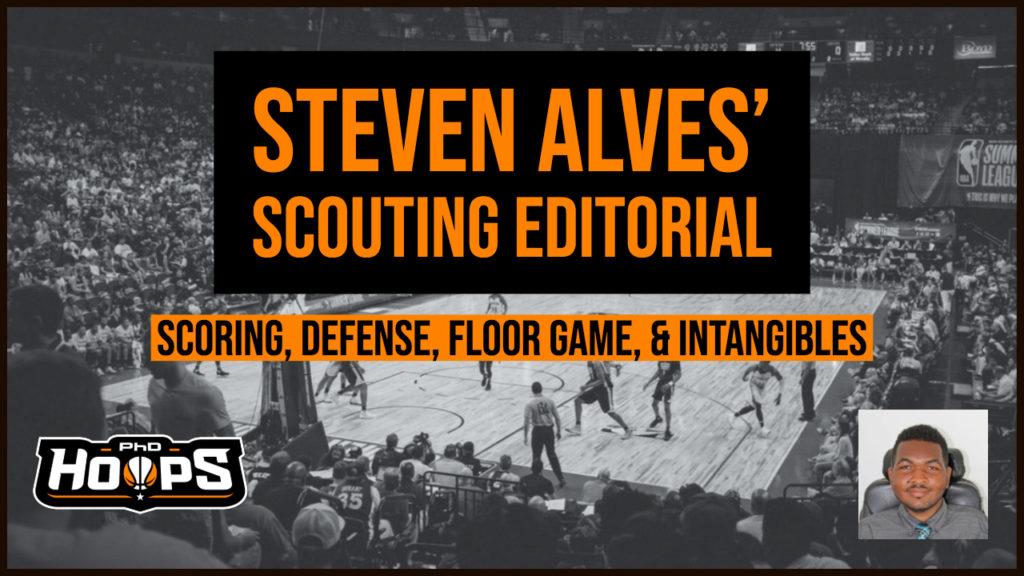Since the age of 11, I have been fascinated with evaluating basketball players. My love of the sport led me to eventually becoming the Special Assistant to the Head Coach at UC Riverside Men’s Basketball. While at UC Riverside, part of my responsibility was evaluating recruits and doing reports for our coaching staff. I also would help out a mentor of mine, Mark Warkentien, who formerly was the Director of Player Personnel for the New York Knicks. I would write scouting reports on collegiate players that Warkentien would ask of me, in order to shed my opinion on their ability to contribute to a team at the NBA level. This led me to taking a certification course in NBA Scouting and General Management at Sport Management Worldwide, that taught me ways to refine my scouting skills. It was here that I learned Rick Barry’s format for creating scouting reports, which has done wonder for the detail that goes into my reports. When scouting a player, I look for four qualities: scoring, defense, the floor game, and intangibles. This post will help to show players what usually catches my eye, and what I am looking for when recommending someone to an executive at the next level.
Scoring
When evaluating a player on offense, I am looking for multiple things. At the professional level, and in most cases with high-caliber Division 1 players, everyone can score. In short, I am always looking to find out the intricacy on how they do it. Details are the most crucial part of evaluating and scouting players.
One of the first things I look for is where the repertoire of his shots come from. This doesn’t always tell the entire story, but it does help to shed light on where they feel most comfortable attempting to score the ball from. After watching a few games, you begin to see how they look to score the ball. This leads me to determine if they are a scorer, pure shooter, or neither. An example of a scorer in the NBA level would be someone like Lou Williams who can beat a team from multiple areas in a half court set. A shooter would be like a Gary Clark or a Nick Young, where most of their shot attempts come from behind the arc.
Once I gather that information, I examine if the player can create his own shot, and whether or not they generally have good shot selection. Creating their own shot is a plus to me, but not mandatory. I put more weight on the shot selection they exhibit during the course of a game. At the professional level, so much of staying on the floor is making the right play. Especially with the way the NBA game is played now concerning the freedom of movement rules, scoring is at an all time high. Not only is it important to maximize the production and flow for the team that the player will be playing for, but it is crucial to minimize the amount of transition opportunities that is allowed to the opposing team. Obviously, there are tough shot makers, but typically, that is not what I am looking for in a player. I want to see that if they get 10-15 minutes on the court, their coach can count on them to make the right plays. On a team with a Kevin Durant or an Anthony Davis, mentally, do you know how to get your shot without disrupting them in the flow of an offense? That is certainly a question I always keep in mind.
Consistency is the final part of the scoring equation. I not only look at a player’s track record to see if they are able to consistently put up good numbers, but what type of year they are having scoring wise is big for me. A big part of my evaluation, especially for scorers, is whether or not his team looks for him to score. Not every player that is a prospect is a go to scorer, but for the ones that have the ability to score, this is a valuable question. Not looking for the player to score isn’t necessarily a bad thing. A player that can put up 15 points (DeAndre Jordan, Clint Capella, etc.) without needing a play called is extremely valuable and noticeable when I scout.
Defense
Defense to me is more about effort, toughness, and mental fortitude than anything else. Obviously physical capabilities play a factor, and I definitely look at that, but I want to see a player’s ability to scrap and use a combination of their physical abilities and mental strength for 48 minutes if asked.
The first aspect that I evaluate when watching a player play defense is whether or not they enjoy it. I know that may sound like a simple question, but it’s an important one. Certain players feed off of the competition on the defensive end. That energy is contagious and changes the mindset of other players on the court. Teammates begin to follow by example and often exert more effort on the defensive end when they see someone defend with a high level of intensity. Team defense also teaches patience, which tends to assist the offensive end as well as a total unit. The focus that teams can string together to create runs can often decide a game, and the catalyst of those runs are often overlooked and valuable.
Next, I look at the player’s physical abilities. Wingspan is one of the most common physical characteristics that scouts look for when evaluating players on defense. A longer wingspan allows for more challenged shots on defense. Especially at the NBA level, players are skilled at creating separation off of dribble moves, so having someone that can shorten the gap on challenges is huge. A longer wingspan also allows for an advantage on the defensive boards, which is one of the most important aspects of playing defense. Athleticism as a whole is also important. Rim protectors are a premium, especially in basketball today. So many teams are going small, thus having someone that can intimidate the opposing team interiorly is an advantage.
It’s important to note whether a player is a better one-on-one defender, or a more effective team defender. With how many ball screens are ran in the NBA, it’s important to have players that are good at both. Talking on defense is so overlooked with players, which often leads to defensive mishaps. Communication is key, so watching a player communicate to his teammates on defense is an important aspect to a team looking for someone that can come in and contribute. Individually, having enough pride to compete one-on-one defensively is also key. Completely shutting down players is a plus, but not realistic on the NBA level. Offensively, players in the NBA are so good, the best efforts on defense are meant to slow them down more than anything. The activity of a player and his ability to constantly compete is the most important aspect in regard to one-on-one ability.
For all players, especially big men, defensive rebounding is a must for me. Quality defense isn’t a missed shot, but how tough you make the possession for an offensive player. Big time players hit big time shots, but generally, 70% of quality defensive possessions end in a missed field goal. The only way to close out a defensive possession other than a steal or forced turnover is to secure a defensive rebound. Paying attention to a player’s attentiveness for getting positioning is big. When a shot goes up, how quickly the player is able to box out and create an advantage rebounding wise is something I’m always looking for. Just as important is how much pride a player takes in getting rebounds. Personally, I like seeing players that are willing to get physical to get a rebound, no matter the scenario. Certain players take offense to not grabbing every possible rebound in their matchup, and I love that mentality. To an extent, height is overrated to me when it comes to rebounding. In higher level basketball it’s about who wants it more, and how attentive you are to the situation. Players like Dennis Rodman and Dejuan Blair were living examples of that, regardless of how much height their matchup had on them.
The Floor Game
The third out of the four sections that I examine heavily is called the floor game. The floor game to me is a player’s ability to make his teammates better. I like to look for different aspects from perimeter and post players when evaluating how well they make their team run efficiently when they are on the floor, although I be sure to comment on any standout abilities that they may have regardless of position.
For perimeter players, I look at their ball handling ability and how well they see the floor. This is important for all the obvious reasons, but I like seeing that they have the ability to navigate ball screens effectively. Being able to get into the lane off of a screen is huge because it shrinks the floor and collapses the defense for open shots, or layups if the defense doesn’t help. Teams are built with an abundance of floor spacing in today’s basketball world, so being able to take advantage of that by creating easy opportunities for teammates is something that is coveted. Also, how well the player can dribble in traffic is something I like to note. Teams look for players that can create easy transition opportunities and see the floor well which is key to getting rare easy baskets.
It is important to see how well guards can move without the ball. Players who know how crucial it is to run routes and screen effectively are invaluable. Often times those end up being the players that are able to get open and find easy opportunities, which every team is looking for.
For post players I am looking for multiple aspects. I want to see how well their hands are, meaning how well they can catch the ball. This isn’t only referring to passes and lob opportunities but rebounding as well. Hand-eye coordination makes a huge difference in any player.
Last, but certainly not least, I am always evaluating a player’s ability to make his teammates better. How do they impact the people on their side of the court? This can go both ways, offensively and defensively. Offensively, having the ability to make the game easier for teammates is an attribute that has positive outcomes at any level. This can be done in a multitude of ways, most commonly drawing defensive attention, and using that as a way to make teammates succeed at their offensive role. Defensively, I look at how well a player communicates, and if they have any attributes that stand out and change the objective of the opposing offense. Shot blockers may intimidate a team from driving, perimeter defensive specialists (Tony Allen etc.) may cause an opposing team to try and run their offense through another source. If a player can change the game, I note it.
Intangibles
Intangibles are a crucial part of evaluating a player that will have success in a team setting. Basketball isn’t golf. It’s not tennis. It’s not boxing or MMA. Basketball is a team sport, and everyone plays their part in making the engine of a successful team run. A basketball player can play well off of talent alone, but they will never achieve success that will make them great without intangibles. For this section of my reports, I do a lot of external research.
The first intangible I look for is the player’s ability to impact a team setting. This can be multiple things in-game, such as examining what the player does during game breaks. Is he actively paying attention during timeouts? How does he interact with his coach? When morale is down, does he uplift his team? Those are all aspects of a player’s in-game mental ability that many people overlook when scouting.
Sacrifice is also crucial both on and off the court. Mentally, being focused on the task while sacrificing for the betterment of the team is the key to success at any level in basketball. Having a willingness to dive for loose balls, take charges, and sacrifice your body for team success shows me that the player wants to win. Those are the players you want to comprise your roster with.
Asking teammates and coaches about a player’s personality is a huge factor in finding the right player. A player knowing that you’re evaluating them to play higher level basketball will always tell you what you want to hear, simply because they want something from you. Asking the people around them, is a more effective way to get the answers you need. As simple as it may sound, it is important when scouting to find out if the player causes “problems”. Problems meaning does he or she create locker room issues, constantly argue and undermine coaches, have off the court issues that negatively affect the team, etc. Any and every detail is important to know when examining character, both good and bad.
Determining a player’s leadership quality is something that can be a game changer for a team. I’ve noticed plenty of talent evaluators have the notion that the best player is the leader of their team. I don’t buy this thought at all. Leadership to me is its own skill, which is entirely separate from a player’s ability to do other aspects on the court. Anyone on a team can lead, look at Derek Fisher when he played for the Lakers, or Nick Collison when he played for the Thunder. Leading is simply unifying a group to accomplish a given task, and not everyone can do that, but the players who can are unique. Examining how a player communicates and guides his teammates is a great way to evaluate leadership qualities.
Lastly, I find it important to examine how often they miss games. A huge aspect for me when evaluating a player in college is availability and consistency. Are they injury-prone? Finding out what type of injuries a player has had in the past, and how they were able to respond to the setback is big in terms of the adversity they can weather. Players will also miss time due to issues off the court, which is important to note as well. Not only can this highlight red flags such as failing drug use policy or grades, but to me it shows that they are willing to risk the success of their team for personal enjoyment, which is selfish and something I’d be sure to note when composing a scouting report.


